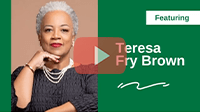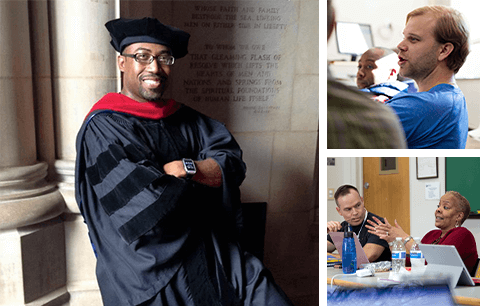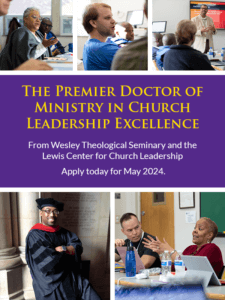
How can preachers keep their preaching fresh? Teresa Fry Brown, professor of preaching at Candler School of Theology, shares strategies for preaching familiar texts for different generations, preaching for in person and digital audiences, and sermon preparation for bivocational pastors.
Listen on Apple Podcasts | Stitcher | Google Podcasts | Spotify
Watch on YouTube

- Transcript — Click or Tap to Read
-
Announcer: Leading Ideas Talks is brought to you by the Lewis Center for Leadership of Wesley Theological Seminary in Washington, DC. Subscribe free to our weekly e-newsletter, Leading Ideas, at churchleadership.com/leadingideas.
Leading Ideas Talks is also brought to you by the premier Doctor of Ministry in Church Leadership Excellence from Wesley Theological Seminary and the Lewis Center for Church Leadership. With this track, clergy will receive the enhanced knowledge, skills, and motivation to increase congregational and denominational service, vitality, and growth. Learn more and apply for May 2024 at wesleyseminary.edu/dmin.
How can preachers keep their preaching fresh? In this episode, Teresa Fry Brown, Professor of Preaching Candler School of the Theology, shares strategies for preaching familiar texts for different generations, preaching for in person and digital audiences, and sermon preparation for bivocational pastors.
Doug Powe: Welcome to the Leading Ideas Talks, a podcast featuring thought leaders and innovative practitioners. I am Douglas Powe, the director of the Lewis Center, and your host for this talk. Joining me is Dr. Teresa Frye Brown. She’s the Bandy Professor of Preaching at Candler School of Theology, the Associate Dean of Academic Affairs, and the author of many books, including Delivering the Sermon. Our focus for this podcast is how to keep preaching fresh.
Dr. Fry Brown, I am so happy that you’re joining us, and people will notice I’m being more official, because Dr. Fry Brown is one of those people that I just can’t use their first name, so you will hear Dr. Fry Brown throughout the podcast. How are you today?
Teresa Fry Brown: I’m doing well, Dr. Powe.
Doug Powe: Oh, see. She’s being funny. She never calls me Dr. Powe.
Teresa Fry Brown: No, I don’t. I always say Douglas.
Doug Powe: She does. That’s right. She does say Douglas. Well, I am happy that you’re with us, and glad that you’re going to talk with us about keeping preaching fresh. I want to begin by asking about preachers who often struggle to preach familiar texts, especially when they have to do it over and over again. Of course, the easy answer is it’s because they preach the text all the time, but I think it probably goes deeper than that. It’s simply: “I’ve looked at this text before.” Could you give any insight into why preachers struggle to teach familiar texts. Or am I actually making more out of this than I should?
Teresa Fry Brown: No, I don’t think that you are making more out of it than you should.
I think that people struggle with repetition because they do not break a text apart and look at different aspects of the text. There’s so much meaning in each and every text that even a comma can change the meaning of it. A diacritical mark can give you something. They don’t practice reading the text in different voices, with different kinds of emotion. I think that when you do that, the text may be the same, but the circumstances surrounding the application of the texts have changed. So, if you are pulling up the same sermon all the time and never refilter it, you’re going to be bored. You will bore yourself, and you’ll bore the people. If you use the same way that you preach all the time — the same process, the same layout — people will start measuring their emotion and their responsiveness because you don’t change at all.
If one thinks that every time you approach a text you are a different person and your experiences are different and that every time the people hear the text their experiences are different, I think you could preach the same text every Sunday for a year and find something different in the text every time you preach the text — if you are aware of the texts, the different translations of the texts, aware of the different people and their experiential base, and aware that you are a different person every time you approach the text.
Doug Powe: Dr. Fry Brown that is quite a challenge — to take the same text and preach it for a year and be able to make it come alive each week in a different way.
Teresa Fry Brown: Yes, and there’s so many for different sermon forms. You could do a topical piece. One of the exercises that I do in Intro to Preaching that you probably had 150 years ago when you were with me is “The joy of the Lord is my strength.” Sometimes people say [listlessly], “the joy of the Lord is my strength.” I go, What! Look at the words: “the joy,” “the joy of the Lord,” “the joy of the Lord is.” Present tense, right? The joy of the Lord is my strength. There we had six or seven different words. You could do you could do a topical thing on joy. You could look at each word each week. You could ask yourself: how does the meaning change if I change the commas? So, there are different ways to do it that I think that could be refreshing. Then also look at the context, the liturgical year context. It’s like, when we’re rolling through Lent, people say to me: how many times can you preach that he got up?
Doug Powe: That’s right.
Teresa Fry Brown: Right? Well, there are different ways to do that or the seven last words or Ash Wednesday. There are so many different that when we have to broaden our idea about what resurrection is and find a different kind of text. We have to broaden what resurrection means with the people that we are preaching to. Since you preach a different sermon for everyone that’s listening to you because they bring themselves to the text, there’s a multiplicity of ways to even preach resurrection.
Doug Powe: Sticking with that for a minute, and I really appreciate that, I’m still thinking about preaching the same text for 52 weeks. If I’m preaching, how am I cognizant that I’m falling into the trap of approaching it the same way? Because I think many people would think I am actually approaching it differently not realizing, “They probably fall into the trap of just doing it in one particular way so they end up at the same place.” Is there a way to catch that so that I can disrupt my pattern of how I preach?
Teresa Fry Brown: I think the word disruption becomes critically important. Some of us schedule out: Today I’m going to work on this verse. Tomorrow I’ll work on the next verse. We routinize things and we begin to bore ourselves. At this time, this is what I’m going to do. Every now and then, develop a different routine for that week because it refreshes you. As pastors, persons have people that are sick, they have budget meetings, they have cleaning out toilets, they have all these things they have to do. And maybe, just maybe, it’s okay for you not to follow that same routine. I’ve had people who say “I can’t preach. I was up all night with the baby being sick.” Were you thinking about things before the baby was sick?
Doug Powe: Hmm!
Teresa Fry Brown: Well, if you’re thinking about the sermon and the text every second (I don’t mean consciously or subconsciously), there’s some engagement with life that should be informing. I always say every second of your life informs your next sermon. You don’t have to use the I do three alliterations, three points, and that’s it. Some Sundays preach one point.
Doug Powe: Yeah, yeah.
Teresa Fry Brown: Some Sundays don’t preach points at all. Some Sundays just preach about a word in the text. So, you can change. There are so many different ways to enter that, but I think we get routinized because it’s easier to follow a routine than to challenge ourselves to do something different. It was kind of like working with pastors during Covid who are so used to, in their pattern of delivery, even of where people would say amen. But now the people aren’t in front of them, so they didn’t have the visual cues as to when to say things, when to raise their voice, when to do all these things, so working with them about reading cues on a flat screen because you were dealing with all these other things during Covid, including your own creativity, and your own isolation rather than developing new habits. I talked with someone yesterday who said in their tradition they preached for two hours.
Doug Powe: Oh, wow.
Teresa Fry Brown: And I went whoa. I’m even talking to people about how you can be very concise and preach the same sermon in less time than an hour — like 12 to 25 minutes, no more than 30 minutes — because people’s listening habits change.
You are a person, too. Your habits of engaging a text change. Your study time has now decreased. The ways in which you use resources have decreased. If you’re preaching the same way you were 25 years ago or 15 years ago or 10 years ago, you need to reevaluate what that is because you become almost calcified in your creative process, and you don’t want that to happen.
 Apply now for the premier Doctor of Ministry in Church Leadership Excellence from Wesley Theological Seminary and the Lewis Center. With this track, clergy will receive the enhanced knowledge, skills, and motivation to increase congregational and denominational service, vitality, and growth. Learn more and apply for May 2024 at wesleyseminary.edu/dmin.
Apply now for the premier Doctor of Ministry in Church Leadership Excellence from Wesley Theological Seminary and the Lewis Center. With this track, clergy will receive the enhanced knowledge, skills, and motivation to increase congregational and denominational service, vitality, and growth. Learn more and apply for May 2024 at wesleyseminary.edu/dmin.
Doug Powe: Thank you. I think that’s helpful. You talked about the pandemic. Of course, I’m not going to say the pandemic’s over, but hopefully we are seeing some light at the end of the tunnel. But now a lot of preachers have to preach to people who are in-person, and they have to preach to a virtual audience. You’re talking about the cues that you have to pay attention to, and this is a different world. You don’t just have the people right in front of you. Now you also have, to some extent, to pay attention to those who are joining you virtually. Do you have any advice for how someone can preach to two audiences at the same time?
Teresa Fry Brown: In my mind, preachers are always preaching to more than one audience.
Doug Powe: Interesting. Okay.
Teresa Fry Brown: Because each person listening has their own hermeneutic. They have their own social location. They have their own way of listening to you. They have things that they’re thinking about that are different than what you are saying. Before 2020, there were people that were selling cassettes and selling floppies and MP3s, so your audience kept growing. Or they’re watching you on live streaming or they’re watching you on television and you never knew exactly who the audience was with whom you were preaching. Someone would go and tell someone about the sermon which may or may not have been what you said in the first place. So, we’ve always had to be cognizant that, yes, there were physically people in front of us, but that did not mean that they are agreeing with us or following along because sometimes we teach people perfunctory responses that don’t necessarily mean that they’re paying attention to what we’re saying. They just know everybody else is saying “amen.” It’s like the collective effervescent waves at football games. Because somebody else is saying it, “Oh! It’s time for me to say amen!”
What happens now because many people were doing sermons on the telephone — they had a camera and a light and their child had the phone — and all these other kinds of things, some of us began attending more to the production than to the word.
Doug Powe: Yeah.
Teresa Fry Brown: Now as things — the pandemic, the endemic nature of Covid and other diseases and racism, all these other things — are still there, I think that people may need to continue to be more cognizant of their facial expressions (which I’ve taught for years as a former speech pathologist) and the language that they use so that the language doesn’t become so colloquial, that it’s language that someone on the other side of the world would understand. Using abbreviations — I’m not saying don’t use them, but once you use a word, there has to be a place for you to explain the word (not the dictionary definition) or reiterate it. You can say the same concept over and over again, but you use different words. Olin Moyd, in the eighties, wrote a book, and he said that you have to reach each age and each of those words will preach. You don’t know who’s listening. Someone could be sitting right in front of you and not pay attention to a word you say. With the persons that are online, you don’t get immediate feedback.
One of my former students, Dominique Robinson, in 2013 started doing the iHomiletic™. What some people are doing is they’re going back and responding to comments in the chat. So, you don’t know while you’re preaching, but you go back later and read the comments in the chat and then respond to those. That gives you a better connection. It should also inform you about what part of the sermon was understood or not that could inform your next sermon. Just like that line that we used to have about when you shook hands at the end of the service where people said that you said things that you know you didn’t say — there are these tools to still get feedback, even though it’s a camera, even though they might be people that you will never see.
There’s a church in Texas, and they call themselves The Wherever. They have a wherever church because they may never see those people. But the people are writing comments and responding to them. So, they have a “Digi Pastor” who goes in and responds as the person in the pulpit is preaching, and I think that’s not going to go away at all.
Doug Powe: Yeah. I appreciate it, and I really appreciate where you started because I think you’re right that, even with those who are there, they do start with a different hermeneutic. So, it really doesn’t matter the location. It’s that you’re trying to reach people who all are going to bring their own hermeneutic to the sermon.
Teresa Fry Brown: That’s true.
Doug Powe: Yeah. You said something that was interesting that I want to pick up on — that in preaching we’re trying to reach different generations, and of course some churches have more generations than others, but still the hope is that you could be spanning anywhere from someone in their nineties to someone who’s 10 years old in your congregation. The hope is that you’re going to be able to say something that connects with all of those individuals.
Teresa Fry Brown: Right.
Doug Powe: Is there a way to do this and to do it well? I mean many people can sort of reach their generation well, but it’s harder for them to move up or to move down.
Teresa Fry Brown: My grandmother at a hundred was listening to rap music because she wanted to be able to communicate with her great-grandchildren. A well-read preacher is a solid preacher. A preacher that is aware of cultures and communities outside of their particular demographic is a solid preacher. It doesn’t mean you try to be the 10-year-old or the 20-year-old, but you should at least be aware of what is grasping their attention at that moment so that you’re not doing this one slice of preaching for everyone that is 10 years either side of who you are. And that means that the preacher has to read and listen, and listen and converse, and listen and watch, and listen in order to, as Moyd would say, reach each age and understand that even within your congregation, with different age groups, different generations, a child who’s being raised by their grandparents has a different point of view than a child who is being raised by their parents.
So, you have to really invest some time. I’m going to say listen again because I think, past your voice, the best sensory kind of input for preachers is listening and watching and observing. In my classes I have people listen to music they wouldn’t ordinarily listen to. I say to preachers you can’t only listen to gospel music and be relevant because some gospel music is not theologically relevant. It’s just not. You can watch reality shows if you want to, but I need you to watch some documentaries also. You could read crime novels, but you may have to read a love novel every now and then because your people are doing that. You have to also be aware of what cultural matters infuse your particular congregation and not be so ready to jump on a sociological study that did not include your people as to when you want to shift how you’re preaching or shift what is going on even in how you’re ordering worship or who’s included in worship.
Doug Powe: And what I have found interesting, and I experienced this with our own son is that even when people, particularly younger people, don’t seem like they’re listening, they’re often listening.
Teresa Fry Brown: Yes.
Doug Powe: So it is important that you actually are trying to make sure that you’re connecting with them, even if it doesn’t feel like it’s a good use of your time.
Teresa Fry Brown: Yes, I mean, I’ve asked people because I’ll hear them use a word and I’ll say, tell me what that means. Tell me what that word means. I don’t necessarily use the word, but I can find a word — because we have 50-60 thousand words that we know — that’s similar to it that might reach someone else with a definition that still lodges with that person. Or I did a sermon Sunday where I did a breadth of songs as a litany, but I knew that I had different people in the congregation that would come in and go “Oh, that’s me! She understands that I exist!” It’s the concept of I see you …
Doug Powe: Yeah.
Teresa Fry Brown: But, also, that I hear you. That, and avoiding illustrations that demean any demographic.
Doug Powe: Yeah.
Teresa Fry Brown: Avoid those. I don’t care what people are saying. Don’t spend time in a sermon talking about those young people. Blah! Those old people. Blah! That negativity pushes them away from hearing the gospel because your illustrations were awful.
Doug Powe: I want to change just a little bit and ask: how can we think about holding together different things in a sermon? So, for example, something happens, like, in Memphis, Tennessee, but it’s also Transfiguration Sunday. So, you’re trying to hold together preaching this very relevant theme that’s in the news, but you also want to pay attention to the liturgical season, to Transfiguration Sunday. You can just pick any time of the year. But how do we hold together multiple things at the same time and do them well? Because the tendency is that I sort of do one well and maybe just mention the other, but I don’t really do justice to both well.
Teresa Fry Brown: Umm, amazingly I’ve had this discussion several times in the last year.
Doug Powe: I can believe it.
Teresa Fry Brown: Or the last two or three years. I think, where I am now as a homiletics professor, is follow what you usually do at your church because you may have been talking about what happened in Memphis before that happened. So, your church already knows your stance on that, and it might be addressed in a prayer or a song or a reading, and then the sermon focuses on whatever that liturgical event is. That’s one way. Another way is, it depends on if I’m preaching Lent or if I’m preaching Good Friday, James Cone talks about the cross and the lynching tree. It falls right together.
Doug Powe: That’s right. Yeah, absolutely.
Teresa Fry Brown: One needs to read the room — I’m having a conference about that later this month — read the room to know in which of those places I’m going to address a social issue. Now, I’m going to complicate matters. I say to people also that perhaps the Sunday after an event happens is not the Sunday to necessarily preach on that event because you do not have all the information. You have what scrolled on the news and more details later. And sometimes, if you have not been addressing that all the way through, you may have the tendency to fall over your feet because you’re giving partial information, and then you have to spend five Sundays saying “I was wrong about this. More has come to light. Maybe we should reconsider.”
You see. So, if you’re known as a pastor/preacher/church that’s always doing things on the front line, they already know where you stand on it, pray about it. If you are not and you focus on other things and use Transfiguration Sunday, you want to talk about transfiguration. Do a prayer. Do a prayer or have a talk after church or something about that. And the next Sunday, address it because you will have more information, and you don’t feel forced into changing, because those last-minute forced sermons fall apart, because your emotional overlay wipes out any kind of call for action, compassion, prayer, whatever, because you are still in shock about what goes on. Sometimes, depending on the location of the church, if this is happening in your city, that may be the Sunday that you read the text from Transfiguration and you pray.
Doug Powe: Yeah.
Teresa Fry Brown: Because that’s as much of a sermon in that moment, because now you’re attending to the aches and pains of the people that are on the front line, or that’s the Sunday that you do a five-minute sermon, and you shift to some other kind of liturgical because I believe that a sermon is part of the worship. It is not the entirety of the worship service, and I think that’s where we get lost — that this is the star event. Just wait, the sermon’s coming. Well, what was the rest of the service and why did you have me sit here for 45 minutes if that didn’t matter? And so it might be that.
And so, we also have to be sensitive enough to know that preaching takes place in different ways. That it’s not always a prescribed little event where somebody does this thing and everybody’s applauding, everybody is grounding. There are other ways to preach. Your action at that time may be the better sermon.
Doug Powe: Our time has gone really quickly, so we’re about to come to a close. I know it has flown by. I’m amazed myself, but I want to end with this question. It’s particularly true now in mainline congregations that, because of decline, you have more and more lay pastors, people who are either bivocational or they work full time and preach on Sunday or people who don’t go through the traditional route to become ordained. What advice can you give to lay pastors particularly, who are bivocational, who don’t have the time necessarily to prepare sermons in the way that someone who is a full-time minister does?
Teresa Fry Brown: Read, read, read, read. Read the text, get into the text until you feel it. Wrestle with the text. Do not compare yourself to anybody else who has preached the sermon before or what you’ve heard. Preach what you know in your head God has given you and in your heart that your people need. It is not a performance or competition moment. It is for you to relay, with passion and compassion, the Word of God that people will live. And, as I say often, love the people enough to want them to live. That’s what I would say to people starting out.
Doug Powe: Dr. Fry Brown, I really appreciate it. This has been excellent, and thank you for your time, you know, because you are the busiest woman in theological education.
Teresa Fry Brown: I love you, Douglas Powe.
Announcer: Thank you for joining us for Leading Ideas Talks.
Don’t forget to subscribe to our free weekly e-newsletter, Leading Ideas, to be notified when new episodes are published. Visit churchleadership.com/leadingideas.
Related Resources
- Preaching Strategies for a Post-Pandemic Church by Michael Adam Beck and Rosario Picardo
- 4 Tips for Preaching on Politically Charged Topics by Ginger Gaines-Cirelli
- 10 Things Great Preachers Do Differently by Charley Reeb
Photo credit: The triangle graphics in the top image are by davidzydd on Freepik.





